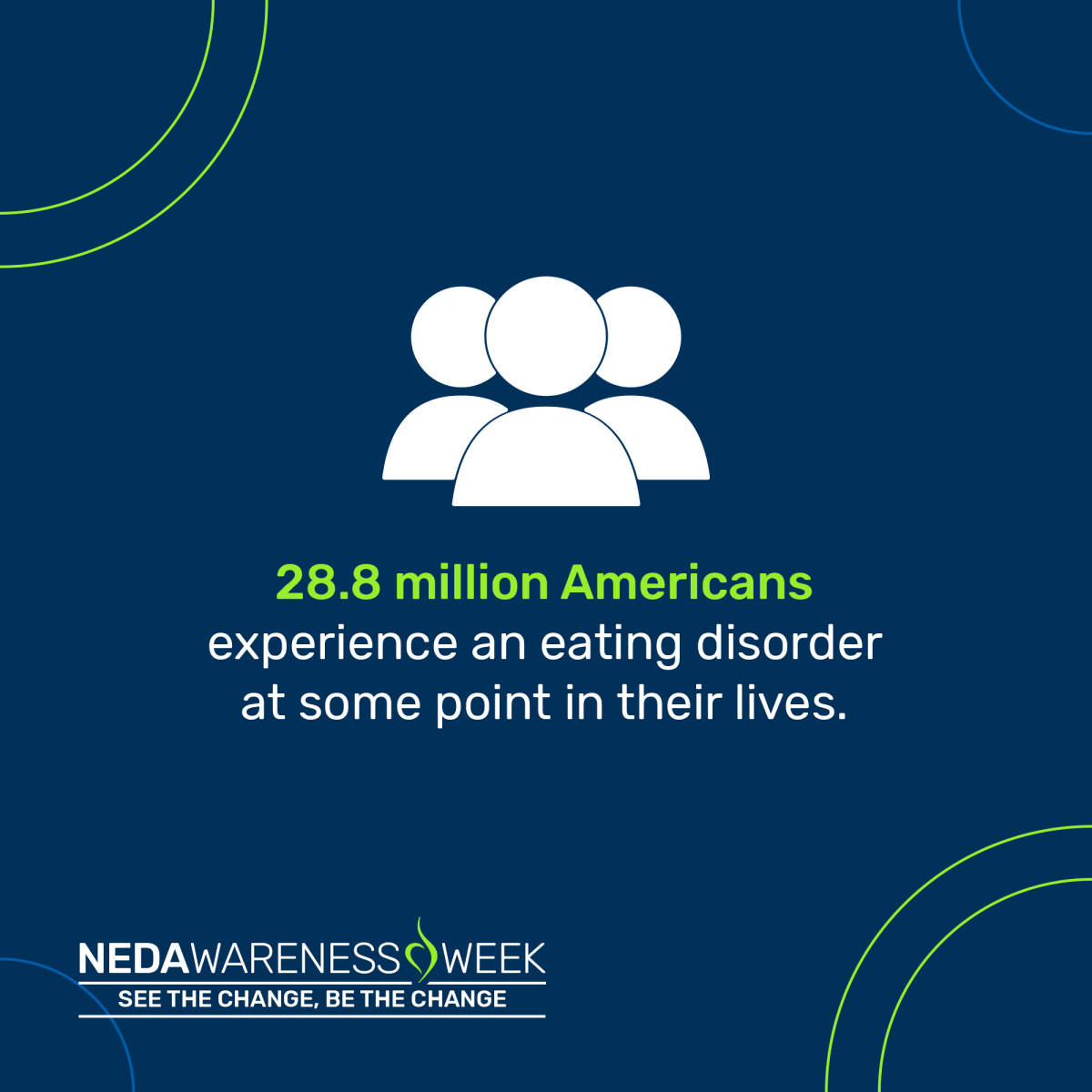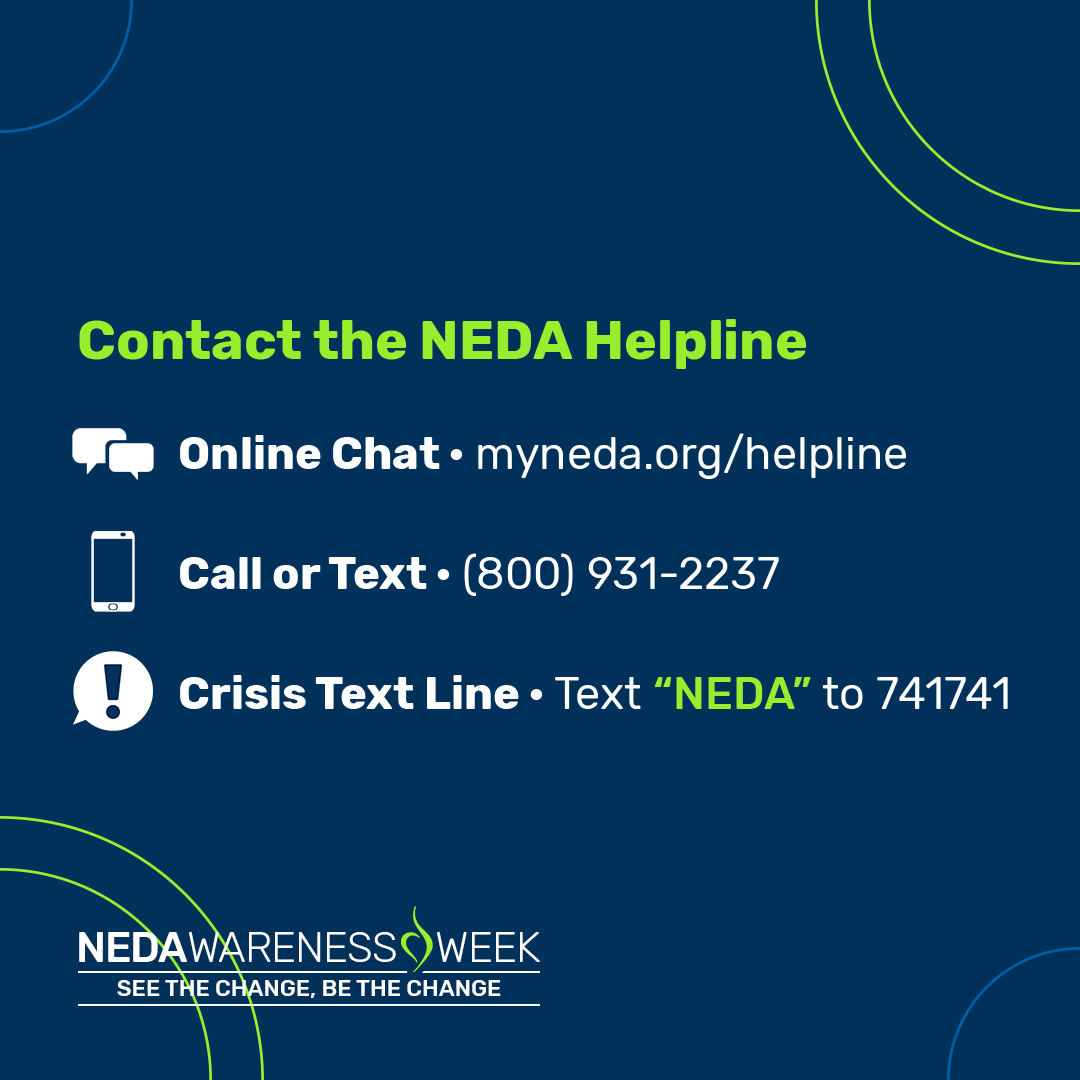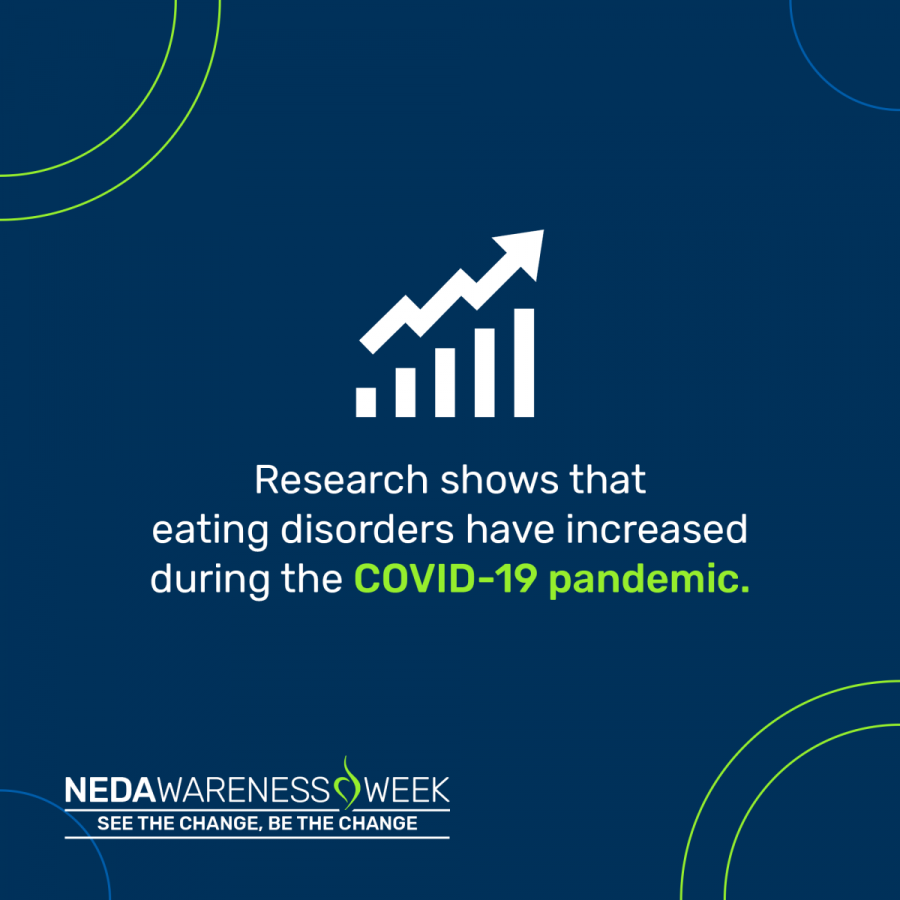It’s More Than Just Eating: The Truth Behind Eating Disorders
March 1, 2022
Unfortunately, the COVID-19 pandemic opened the door to many developing or worsening mental illnesses, such as eating disorders. This year more than ever, it’s important to bring awareness to these illnesses and offer support to those struggling.
Please note: This article discusses eating disorders, the severity of these illnesses, and ways you can help make a change. The Lancer Ledger staff are not experts on eating disorders nor certified to give out medical help. If you are struggling, we strongly encourage you to reach out to a qualified specialist.
Eating disorders are both mental and physical illnesses that can affect any person, no matter their age, weight, height, race, gender, or and/or ethnicity. Despite the fact eating disorders are treatable, they are very serious diseases that can have severe or even life-threatening effects on an individual. In today’s society, eating disorders are far too often misunderstood. With National Eating Disorder Awareness Week recently passing in February, there is no better time than now to become educated on eating disorders and ways you can make a difference in the lives of those struggling.
What Is National Eating Disorder Awareness Week?
Beginning on February 21, 2022 and ending on February 27, 2022, National Eating Disorder Awareness Week (NEDAwareness Week) was devised by The National Eating Disorders Association (NEDA). The group is “dedicated to supporting individuals and families affected by eating disorders.” NEDAwareness Week is an “annual campaign” designed to help “educate the public about the realities of eating disorders” along with providing “hope, support, and visibility” to individuals and families impacted by eating disorders.
NEDA uses the slogan “See the change, Be the change” to invite the public to be a part of the awareness week. Throughout the week, NEDA encourages individuals to recognize “change within ever-evolving eating disorders” and become the change through “advocacy, awareness, and community building.”
This year’s NEDAwareness week was a grand success. Many eating disorder victims shared their stories on social media platforms and/or created infographics, which were then spread by the public, to provide education on the realities of eating disorders. The week also received much national attention; several United States landmarks lit up in the signature eating disorder awareness colors blue and green to recognize NEDAwareness week.
What Types Of Eating Disorders Exist?
There is not just one specific eating disorder, in fact there are various types. The Diagnostic and Statistical Manual of Mental Disorders, Fifth Edition (DSM-5) serves as an official guide for mental illnesses. The DSM-5 provides the necessary criteria needed to assess and diagnose specific mental disorders. Among these include the diagnosis for eight types of eating disorders: Anorexia Nervosa, Binge Eating Disorder, Bulimia Nervosa, Avoidant Restrictive Food Intake Disorder (AFRID), Pica, Rumination Disorder, Unspecified Feeding or Eating Disorder (UFED), and Other Specified Feeding or Eating Disorder (OSFED). Enough information has been gathered from reviewing these eating disorders for the DSM-5 to generate a “rulebook” in order to diagnose these mental conditions. With that being said, many medical professionals still recognize newer types of eating disorders, like Orthorexia, that still do not have a universally accepted definition yet.

Are All Eating Disorders The Same Or Different?
In short, all eating disorders are different. While some may share similarities, ultimately, the disorders all vary enough from each other to be separated into numerous types. Anorexia Nervosa for example consists of an individual restricting their energy intake and having a fear of weight gain. The body enters a state of starvation, and the patient is typically underweight. On the other hand, Binge Eating Disorder is characterized by an individual partaking in binge episodes where they feel a lack of control while eating. According to NEDA, during these binges, the individual may feel unable to stop eating food surpassing fullness, “eat more rapidly than normal”, and/or feel “embarrassed” or “very guilty” afterwards. These binges are recurrent, and not to be confused with overeating on special occasions for a day or two. To learn more about each type of eating disorders, check out the NEDA’s information guide here.
Everyone dealing with an eating disorder has their own experience, so the criteria for diagnosing an eating disorder differs for each individual. Something that may trigger one individual, may not affect another. Different factors, environments, and overall lifestyles are common contributors to the development of eating disorders, and will affect each person uniquely. Therefore, it is crucial that eating disorders are not stereotyped, as two people could be fighting the same illness while undergoing vastly different experiences.
Why Do Eating Disorders Arise Amongst Individuals?
There is no single cause for eating disorders. But as mentioned previously, different factors can play a role in the formation of eating disorders. Like the NEDA categorizes, these factors can best be broken down into three groups: biological, psychological, and social.
While it may not seem like it, biology can play a role in the emergence of eating disorders. Take genetics as an example. According to Mayo Clinic, certain individuals have “genes that increase their risk of developing eating disorders.” Likewise, other biological factors like “changes in brain chemicals” can lead one to develop an eating disorder. Studies have also found that individuals who are surrounded by a first-degree relative who is dealing with an eating disorder increases their own risk of developing an eating disorder.
Psychology is another prominent factor that increases one’s susceptibility in developing an eating disorder. Perfectionism has been linked to the formation of eating disorders. This is due to the fact that an individual will begin to set incredibly high standards for themselves that become too unrealistic to obtain. Body image has significantly proven to play a role in the development of eating disorders as well. While many people unfortunately struggle with accepting their appearance, the NEDA states that those with eating disorders have reported “higher levels of body image dissatisfaction and an internalization of the appearance ideal.” Studies have also proven that those with already existing disorders are more likely to develop eating disorders. In a study of “more than 2400 individuals hospitalized for an eating disorder,”, the NEDA found 97% of the patients had one or more co-occurring conditions, with 94% having co-occurring mood disorders, specifically depression. 56% of the patients also showed results of having an anxiety disorder as well, including Obsessive-Compulsive Disorder, Post-Traumatic Stress Disorder, and alcohol or substance abuse.
Social factors have also proven to play a significant role in stirring up eating disorders. The media and its creation of diet culture has become a very relevant factor in eating disorder diagnoses. As body image researcher Nadia Craddock defines it, diet culture is the set of expectations that states “there’s one way to be and one way to look and one way to eat and that we are a better person, we’re a more worthy person if our bodies are a certain way.” Diet culture has prompted the idea of unattainable beauty standards within past decades, promoting the false idea that existing in a thin body, as opposed to a large one, is the healthiest, best version of you. This reinforces the incorrect idea that weight gain is morally bad and should be avoided at all costs. These expectations and fears have deceived many individuals to believe they must change their appearance to be socially acceptable, which has led to the development of eating disorders amongst many. Bullying, teasing, and weight shaming are other social factors that have been linked to causing eating disorders amongst individuals. Words can affect a person deeper than the eye can see, and therefore it is crucial to be kind and accepting of all kinds of people, no matter how they look.
What Are The Consequences Of Eating Disorders?
Eating disorders are often glamorized on social media, but their realities are far from anything beautiful. Eating disorders are serious illnesses, and have the capability to be life threatening. When one undergoes an eating disorder, both their physical and mental health are at risk.
With many eating disorders, the body enters a fight or flight mode. The body is no longer able to trust the individual to properly meet its needs, and therefore one becomes out of tune with their hunger signals. The body is unable to depend on the human to adequately and frequently provide the food and nutrition it needs to function.
But being out of tune with one’s body is just the beginning of many dangerous effects. When the body does not receive enough calories, it begins to break down its own tissue for a source of fuel. The body’s resting metabolic state is then also reduced, as the body desperately attempts to conserve energy, Muscles are the first tissue to be broken down, which means the heart, the body’s most important muscle, will be greatly affected. The NEDA explains how as the blood has less fuel to pump blood, pulse and blood pressure begins to drop, increasing the risk for heart failure.

Restricting food and/or purging by vomiting skews the stomach’s “normal emptying and digestion of nutrients.” As a result, digestion becomes slowed, causing symptoms such as bloating, constipation, blocked intestines of undigested food, bacterial infections, blood sugar fluctuations, and feelings of fullness after eating minimal amounts of food. Frequent vomiting can cause sore throats, a hoarse voice, and in worst scenarios, cause the esophagus to rupture. Binge eating in particular can cause the stomach to rupture, which is “life-threatening.” Consumption of nonfood items, which is present in eating disorders like Pica, can cause blockages in the intestines or infections, as foreign materials can poison the body.
Restriction, starvation, and/or irregular eating patterns result in a decrease of energy given to the brain. As a consequence, individuals with eating disorders tend to experience brain fog and food-obsessive thoughts consume one’s head. The irregularity and/or lack of eating can also cause difficulty sleeping for individuals. Some of the neurological risks are more severe, such as risks of fainting if the brain does receive enough blood. Along with this, the NEDA analyzes how the “body’s neurons require an insulating, protective layer of lipids” in order to conduct electricity. An insufficient fat intake can damage this layer, and cause feelings of numbness and tingling in body parts like the hands.
A low caloric and fat intake can cause dry skin and brittle hair that may start to fall out. The inadequate nutrition in eating disorders can decrease the number of certain blood cells, like the infection-fighting white blood cells, which can lead to becoming ill more easily or the development of anemia. In eating disorders like Anorexia Nervosa, where the body is in starvation mode, hair will begin to grow as the body tries to preserve warmth.
Eating disorders do not just negatively affect physical health; they take a massive toll on one’s mental health as well. Body dysmorphia, body image dissatisfaction, fear foods, obsessive and controlling food thoughts and rules – these are just a few of the symptoms that may cause the mental health of an eating disorder victim to suffer. As one battles their illness, their personality may alter, and they become more irritable and easily angered. Those struggling with eating disorders may begin to isolate themselves, causing them to grow distant from friends and family. Some patients may have been medically required to halt exercise until they are in a healthier place, which greatly impacts those whose passion lies within a sport.
What Are Some Common Misconceptions About Eating Disorders?
Like any illness, truths and misinformation overlap, causing misconceptions to arise. Below is a list of common eating disorder myths that are proven to be incorrect.
You have to be underweight to have an eating disorder
Eating disorders do not have a specific appearance. They are mental illnesses. Anyone can develop an eating disorder, no matter their size. Even if someone “looks” like they are at a healthy weight for their body, they can still be struggling with any type of eating disorder. This myth also corresponds with the incorrect idea that you have to be very thin in order to have Anorexia Nervosa. Again, eating disorders are mental illnesses, meaning anyone can be mentally battling one. It is the mental illness that leads to physical effects, like weight loss, in Anorexia Nervosa patients.
Everyone binges
Everyone overindulges once in a while, but everyone does not binge. Binge Eating Disorder is a serious illness where an individual frequently consumes large portions of food due to feeling out of control. These binges usually stem from restriction and avoidance of foods, or as a way to cope with heavy emotions. It is normal to eat past fullness on holidays, vacations, at restaurants, or during other special occasions. But this is not binging; this is indulging in life and living with balance. Binges are severe and unfortunately cause individuals to feel immense amounts of guilt and shame after eating.
Only females can have eating disorders
Eating disorders do not have requirements, meaning they can affect anyone. As observed by the NEDA, in 1999 to 2009, hospitalizations for male eating disorder patients increased by 53%. Research has also conducted a percentage of the prevalence of male patients among three of the most common eating disorders: 25% for Anorexia Nervosa, 36% for Binge Eating Disorder, and 25% for Bulimia Nervosa. Additionally, various studies have also suggested that males have a higher mortality rate from eating disorders than females.
Only teenagers will develop eating disorders
According to the NEDA, studies have shown that an increase in eating disorder diagnoses among children is becoming prominent. Many individuals have also confirmed that their disordered eating thoughts began to emerge within their early childhood. Men and women adults have also reported cases of eating disorders, whether this be from “a relapse, ongoing illness from adolescence or young adulthood, or due to the onset of a new eating disorder.”
New research suggests that children experience weight bias as young as three years old, and that if left unchecked, it can lead to an #eatingdisorder.
Read more about weight bias, and how parents, guardians, and educators can get ahead of the problem: https://t.co/OBFFuEPkpk
— NEDA (@NEDAstaff) February 28, 2022
All eating disorder patients are hospitalized
While some cases of eating disorders do require the individuals to be medically institutionalized due to health concerns, some patients may be able to recover from their own home. While recovering, most individuals will attend scheduled therapy sessions and medical check-ins. Other patients may reside in a residential center, where they are given care 24/7 from medical and therapeutic staff. The patients live at these facilities throughout their recovery, and may engage in activities like group therapy, eating meals together, and tutoring if the individual is a student. The patients are monitored, and given meals and snacks to eat during their time of treatment.
Once someone is recovered, they will never deal with an eating disorder again
Recovery from an eating disorder is not linear. Setbacks and hard days are bound to happen in anyone’s journey. But good days and recovery wins are inevitable as well. An individual will be able to improve their relationship with food and heal themselves from their illness, but relapses are possible and do occur. Even if someone does not completely relapse, they still may experience occasional triggers and thoughts throughout their life.
How You Can Make A Difference

Offering your support to an individual struggling with an eating disorder is one of the most beneficial actions you can do. However, it is important to know that while you may say something with good intentions, someone with an eating disorder can easily be triggered. Therefore, educating yourself on eating disorders, what can trigger a patient, and eating disorder terminology is a crucial way you can help a loved one who is struggling.
Donating is another way to help those struggling with eating disorders. You can donate to the NEDA here, where the money goes toward “prevention programming, education, and support resources.” Participating and recognizing National Eating Disorder Awareness Week annually is another way you can help make a difference when it comes to eating disorders.
If you or a loved one is struggling with an eating disorder, remember that things will get better. While the road may be rocky, a light at the end of the tunnel can always be found. On behalf of The Lancer Ledger staff, we encourage you to become educated on the topic of eating disorders and offer our support to individuals affected by eating disorders.
